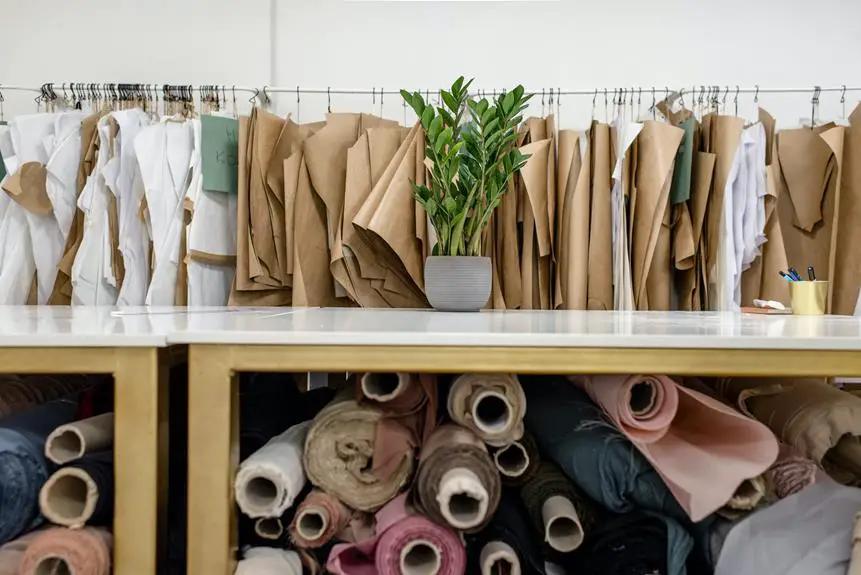Looking to elevate your next project with fabric that moves like a second skin? Synthetic stretch fabric might just be the ideal choice for you. This versatile material offers a perfect blend of flexibility, durability, and style, making it a top contender for any endeavor requiring precision and performance.
From activewear to formal attire, the possibilities are endless when it comes to crafting with synthetic stretch fabric. In this guide, we'll delve into the myriad benefits, tips, and tricks for working with this innovative textile, helping you master its potential and create impeccable pieces that stand out.
Whether you're a seasoned pro or a budding enthusiast, exploring the world of synthetic stretch fabric is sure to expand your creative horizons.
Key Takeaways
- Synthetic stretch fabric offers comfort, ease of movement, and maintains shape even after repeated wear and washing.
- It is ideal for athletic wear, swimwear, and form-fitting clothing due to its superior stretch and recovery compared to natural fibers.
- When choosing synthetic stretch fabric, consider material properties such as stretch, durability, abrasion resistance, and colorfastness.
- Sewing with synthetic stretch fabric requires using a stretch needle, high-quality fabrics with good recovery, stretch stitches or narrow zigzag stitches, and considering challenges such as hemming difficulties and maintaining fabric integrity.
The Benefits of Synthetic Stretch Fabric
If you're looking for a fabric that offers flexibility and durability, synthetic stretch fabric may be the perfect choice for your next project. Synthetic stretch fabric properties are designed to provide comfort and ease of movement. The unique blend of materials allows the fabric to stretch and recover, making it ideal for garments that require flexibility, such as activewear or form-fitting clothing. Unlike natural fibers, synthetic stretch fabric is engineered to maintain its shape, even after repeated wear and washing, ensuring that your creations will continue to look great over time.
When comparing stretch fabric vs natural fibers, synthetic stretch fabric often outperforms natural fibers in terms of elasticity and resilience. While natural fibers like cotton and wool have their own merits, they lack the same level of stretch and recovery that synthetic stretch fabric offers. This makes synthetic stretch fabric particularly suitable for athletic wear, swimwear, and other apparel where freedom of movement is essential.
Choosing the Right Type of Synthetic Stretch Fabric
When choosing the right type of synthetic stretch fabric, it's important to consider the material properties, ideal garment applications, and care and maintenance tips.
Understanding how different synthetic stretch fabrics compare in terms of stretch, durability, and breathability will help you select the best option for your project.
Additionally, knowing which types of garments each fabric is best suited for, as well as how to properly care for and maintain them, will ensure the longevity and performance of your creations.
Material Properties Comparison
When choosing the right type of synthetic stretch fabric for your project, consider the material properties for a precise fit and desired performance. Material stretchability is a crucial factor to examine. Look for fabrics with excellent stretch recovery, ensuring that your garment retains its shape and provides a comfortable range of motion.
Additionally, fabric durability is paramount for long-lasting wear. Seek fabrics with high abrasion resistance and colorfastness to maintain the garment's appearance after frequent use and washings.
Understanding these material properties will guide you in selecting the ideal synthetic stretch fabric for your specific project, ensuring that it meets your performance and longevity requirements.
Ideal Garment Applications
Choosing the right type of synthetic stretch fabric for your project depends on the specific applications you have in mind.
Consider the stretch fabric suitability for the intended garment. For activewear, opt for fabrics with high elasticity such as spandex or elastane blends to allow for ease of movement.
When designing form-fitting apparel like leggings or swimwear, look for fabrics that offer excellent shape retention.
For casual wear, fabrics with moderate stretch are suitable, providing comfort without excessive cling.
Additionally, evaluate the design possibilities offered by different synthetic stretch fabrics. Some fabrics may be better suited for creating structured garments, while others are ideal for draping and fluidity.
Care and Maintenance Tips
To ensure the longevity and performance of your synthetic stretch fabric, it's essential to follow specific care and maintenance tips tailored to the fabric type and garment application. Always refer to the washing instructions on the fabric label.
Most synthetic stretch fabrics are machine washable, but using a gentle cycle and cold water will help preserve the fabric's elasticity. Avoid using bleach or fabric softeners as they can break down the fibers.
When it comes to stain removal, address stains promptly using a gentle stain remover or a mixture of mild detergent and water. Blot the stain rather than rubbing to prevent damage to the fabric.
Always air dry synthetic stretch fabrics to prevent shrinking and maintain their shape.
Sewing Tips for Working With Synthetic Stretch Fabric
Consider using a stretch needle when sewing with synthetic stretch fabric to prevent skipped stitches and fabric damage.
For fabric selection, opt for a high-quality synthetic stretch fabric with good recovery to ensure the finished garment retains its shape. Look for options such as polyester-spandex blends or nylon-spandex blends.
When it comes to stitching techniques, use a stretch stitch or a narrow zigzag stitch to allow the seams to stretch with the fabric. This helps to prevent seam breakage when the garment is worn or stretched.
Additionally, using a walking foot attachment on your sewing machine can help to feed the fabric evenly, preventing the layers from shifting and resulting in a more professional finish.
Remember to test your stitching on a scrap piece of fabric before sewing your project to ensure the tension and stitch length are appropriate.
Styling Ideas for Synthetic Stretch Fabric Projects
When working on projects with synthetic stretch fabric, you can enhance the overall look by incorporating thoughtful styling elements that complement the fabric's flexibility and comfort.
Design inspiration for synthetic stretch fabric projects can be drawn from various sources such as athleisure wear, activewear, and high-fashion garments. Consider incorporating elements like strategic color blocking, asymmetrical hemlines, or innovative seam placements to maximize the fabric's stretch and create visually dynamic pieces.
Color combinations play a crucial role in styling synthetic stretch fabric projects. Bold and vibrant color combinations can add an energetic and modern touch to your creations, while monochromatic schemes can exude sophistication and elegance.
Additionally, don't shy away from experimenting with textures and patterns to add depth and visual interest to your designs. Whether you opt for a minimalist approach or embrace bold and unconventional designs, synthetic stretch fabric provides the versatility to bring your creative vision to life.
Care and Maintenance of Synthetic Stretch Fabric
For maintaining the quality and longevity of your synthetic stretch fabric, it's essential to follow specific care guidelines provided by the fabric manufacturer. Proper care and maintenance will ensure that your fabric retains its elasticity, color, and overall appearance for a long time.
Here are some important tips to keep in mind:
- Cleaning Instructions: Always check the care label on your synthetic stretch fabric to determine the recommended cleaning method. Typically, these fabrics can be machine washed in cold water on a gentle cycle. Use a mild detergent and avoid fabric softeners, as they can break down the elasticity of the fabric. For delicate items, hand washing is often the best option. Additionally, avoid using bleach and opt for air-drying instead of using a dryer to prevent damage.
- Storage Solutions: To maintain the shape and quality of your synthetic stretch fabric, it's crucial to store it properly. Avoid hanging stretch fabrics, as this can cause them to lose their shape over time. Instead, neatly fold the fabric and store it in a cool, dry place away from direct sunlight to prevent discoloration and damage.
Following these cleaning instructions and storage solutions will help you keep your synthetic stretch fabric in optimal condition, ensuring that your projects look their best for years to come.
Overcoming Challenges When Using Synthetic Stretch Fabric
When working with synthetic stretch fabric, you may encounter challenges such as handling hemming difficulties, ensuring a proper fit, and maintaining the fabric's integrity.
To overcome these challenges, fabric care tips, sewing techniques for fit, and strategies for handling hemming challenges are essential.
Fabric Care Tips
To maintain the quality and durability of synthetic stretch fabric, it's essential to follow proper care guidelines for the fabric's unique properties. Here are some fabric care tips to help you overcome challenges when using synthetic stretch fabric:
- Stain Removal: Use a gentle stain remover and avoid harsh chemicals to preserve the fabric's longevity.
- Fabric Longevity: Wash synthetic stretch fabric in cold water to prevent stretching and maintain its shape over time.
- Ironing and Storage Techniques: When ironing, use a low heat setting to avoid damaging the fabric, and store the fabric flat or rolled up to prevent wrinkles and creases.
Following these fabric care tips will ensure that your synthetic stretch fabric maintains its quality and resilience for your next project.
Sewing Techniques for Fit
Maintaining the resilience of synthetic stretch fabric necessitates employing precise sewing techniques for a tailored fit, ensuring optimal performance and comfort.
When working with synthetic stretch fabric, pattern adjustments are crucial for achieving the perfect fit. Consider using patterns specifically designed for stretch fabrics or modify traditional patterns by adding extra ease at the seams.
Additionally, fabric manipulation techniques such as stretching the fabric as you sew or using a walking foot can help prevent puckering and distortion. Always use a ballpoint or stretch needle to avoid damaging the fabric and ensure smooth, even stitches.
Remember to test your sewing techniques on a scrap piece of fabric before starting your project to ensure the best results.
With these tips, you can conquer the challenges of sewing with synthetic stretch fabric and create beautifully fitted garments.
Handling Hemming Challenges
You may encounter difficulty when hemming synthetic stretch fabric due to its inherent elasticity and resilience. To overcome these challenges, consider the following:
- Hemming techniques: Experiment with different hemming techniques such as using a walking foot or a stretch needle to prevent skipped stitches and fabric distortion.
- Fabric manipulation: Gently stretch the fabric as you sew to ensure the hem retains the fabric's stretch while preventing it from puckering or becoming too tight.
- Stretch fabric challenges, finishing options: Explore options like using a twin needle for a professional finish, applying clear elastic in the hem to maintain stretch, or using a coverstitch machine for a professional-looking hem.
Successfully hemming synthetic stretch fabric involves mastering these techniques and understanding the fabric's behavior to achieve professional results.
Frequently Asked Questions
Can Synthetic Stretch Fabric Be Used for Outdoor or Athletic Wear?
For outdoor or athletic wear, synthetic stretch fabric excels in moisture-wicking and breathability, keeping you dry and comfortable. Its durability and flexibility provide the ideal combination for high-performance activities, making it a perfect choice.
Are There Any Environmental Concerns Associated With the Production of Synthetic Stretch Fabric?
When considering synthetic stretch fabric, it's important to be aware of its environmental impact. The production process of synthetic fabrics can contribute to pollution and resource depletion, so it's crucial to weigh these factors in your decision-making.
Can Synthetic Stretch Fabric Be Dyed or Printed With Custom Designs?
Yes, synthetic stretch fabric offers many dyeing options and printing capabilities, allowing you to create custom designs for your projects. It provides versatility and vibrant results, giving you the freedom to express your creativity.
What Is the Typical Lifespan of Synthetic Stretch Fabric Compared to Natural Fibers?
When comparing synthetic stretch fabric to natural fibers, consider durability, maintenance, and sustainability. Synthetic fabrics typically have a longer lifespan, require less maintenance, and offer excellent dyeing and printing capabilities. They also provide comfort and health benefits.
Are There Any Potential Health Risks Associated With Wearing Synthetic Stretch Fabric?
When considering synthetic stretch fabric, it's important to be aware of potential allergies, skin irritations, and chemical exposure. Investigate fabric sourcing, manufacturing processes, and recycling/disposal methods to make an informed decision for your next project.
- Tetron Fabric for Marine Applications: Durability and Use Cases - June 18, 2025
- Tetron Fabric for Outdoor Furniture: Weather Resistance and Care - June 18, 2025
- Tetron Fabric for Wall Coverings: Style and Application Tips - June 18, 2025







